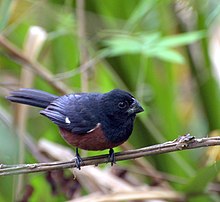Chestnut-bellied seed finch
| Chestnut-bellied seed finch | |
|---|---|

| |
| male | |

| |
| female | |
| Scientific classification | |
| Domain: | Eukaryota |
| Kingdom: | Animalia |
| Phylum: | Chordata |
| Class: | Aves |
| Order: | Passeriformes |
| Family: | Thraupidae |
| Genus: | Sporophila |
| Species: | S. angolensis
|
| Binomial name | |
| Sporophila angolensis (Linnaeus, 1766)
| |

| |
| Synonyms | |
| |
The chestnut-bellied seed finch (Sporophila angolensis) is a species of bird in the family Thraupidae, but was until recently placed in Emberizidae.
It is found widely in shrubby and grassy areas in tropical and subtropical South America. It has been replaced west of the Andes (and in Central America) by the closely related thick-billed seed finch (S. funerea). The two have often been considered conspecific as the lesser seed-finch, using the older scientific name Oryzoborus angolensis.
Taxonomy
The chestnut-bellied seed finch was formally described by the Swedish naturalist Carl Linnaeus in 1766 in the twelfth edition of his Systema Naturae under the binomial name Loxia angolensis.[2] Linnaeus based his description on "The Black Gros-Beak" that had been described and illustrated in 1764 by the English naturalist George Edwards.[3] Edwards's illustration was from a live bird belonging to the barrister Philip Carteret Webb. Edwards mistakenly believed that the bird had come from Angola. The chestnut-bellied seed finch does not occur there and the type locality is now designated as eastern Brazil.[3][4]
The chestnut-bellied seed finch and the thick-billed seed finch were formerly considered conspecific and together had the English name "lesser seed-finch".[5][6] Both species were formerly placed in the genus Oryzoborus but molecular phylogenetic studies found that Oryzoborus was embedded in Sporophila.[7][8] The chestnut-bellied seed finch was therefore moved to Sporophila, a genus that had been introduced by the German ornithologist Jean Cabanis in 1844.[9][10]
Two subspecies are recognised:[10]
- S. a. torrida (Scopoli, 1769) – Trinidad, Tobago, east Colombia, Venezuela, the Guianas and north, west Amazonia
- S. a. angolensis (Linnaeus, 1766) – north Bolivia to east Brazil, Paraguay and northeast Argentina
References
- ^ BirdLife International (2018). "Sporophila angolensis". IUCN Red List of Threatened Species. 2018: e.T22723542A132167022. doi:10.2305/IUCN.UK.2018-2.RLTS.T22723542A132167022.en. Retrieved 12 November 2021.
- ^ Linnaeus, Carl (1766). Systema naturae : per regna tria natura, secundum classes, ordines, genera, species, cum characteribus, differentiis, synonymis, locis (in Latin). Vol. 1, Part 1 (12th ed.). Holmiae (Stockholm): Laurentii Salvii. p. 303.
- ^ a b Edwards, George (1758–1764). Gleanings of Natural History, exhibiting figures of quadrupeds, birds, insects, plants &c... (in English and French). Vol. Part 3. London: Printed for the author, at the College of Physicians. p. 296, Plate 352.
- ^ Paynter, Raymond A. Jr, ed. (1970). Check-List of Birds of the World. Vol. 13. Cambridge, Massachusetts: Museum of Comparative Zoology. p. 150.
- ^ Paynter, Raymond A. Jr, ed. (1970). Check-List of Birds of the World. Vol. 13. Cambridge, Massachusetts: Museum of Comparative Zoology. pp. 149–150.
- ^ Committee on Classification and Nomenclature (1983). Check-list of North American Birds (6th ed.). Washington, DC: American Ornithologist's Union. p. 689. ISBN 0-943610-32-X.
- ^ Mason, Nicholas A.; Burns, Kevin J. (2013). "Molecular phylogenetics of the Neotropical seedeaters and seed-finches (Sporophila, Oryzoborus, Dolospingus)" (PDF). Ornitologia Neotropical. 24: 139–155.
- ^ Burns, K.J.; Shultz, A.J.; Title, P.O.; Mason, N.A.; Barker, F.K.; Klicka, J.; Lanyon, S.M.; Lovette, I.J. (2014). "Phylogenetics and diversification of tanagers (Passeriformes: Thraupidae), the largest radiation of Neotropical songbirds". Molecular Phylogenetics and Evolution. 75: 41–77. doi:10.1016/j.ympev.2014.02.006. PMID 24583021.
- ^ Cabanis, Jean (1844). "Avium conspectus quae in Republica Peruana reperiuntur et pleraeqiio observatae vel collectae sunt in itinere a Dr. J.J. de Tschudi". Archiv für Naturgeschichte (in Latin). 10: 262–317 [291].
- ^ a b Gill, Frank; Donsker, David; Rasmussen, Pamela, eds. (July 2020). "Tanagers and allies". IOC World Bird List Version 10.2. International Ornithologists' Union. Retrieved 26 November 2020.
Further reading
- Lill, Alan (1974). "Behavior of the grassland sparrow and two species of seed-finches" (PDF). The Auk. 91 (1): 35–43. doi:10.2307/4084659. JSTOR 4084659.
![]() Media related to Oryzoborus angolensis at Wikimedia Commons
Media related to Oryzoborus angolensis at Wikimedia Commons
- CS1: long volume value
- CS1 Latin-language sources (la)
- CS1 French-language sources (fr)
- Articles with short description
- Short description matches Wikidata
- IUCN Red List least concern species
- Articles with 'species' microformats
- Commons link is locally defined
- Taxonbars desynced from Wikidata
- Taxonbars with automatically added original combinations
- Sporophila
- Birds of the Amazon rainforest
- Birds of Colombia
- Birds of Venezuela
- Birds of Trinidad and Tobago
- Birds of the Guiana Shield
- Birds of Brazil
- Birds of Paraguay
- Birds of the Caribbean
- Birds described in 1766
- Taxa named by Carl Linnaeus
- Taxonomy articles created by Polbot
- All stub articles
- Thraupidae stubs
